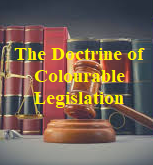The doctrine of colourable legislation essentially deals with the conflict between the laws of Centre and State. India adopts a federal structure of governance, therefore the extent of legislative powers is distributed between the Centre and the States. As per Article 245, Parliament may make laws for whole or any part of India and the legislature of a State may make laws for whole or any part of the State and Article 246 clearly mentions the extent of legislative powers of the Parliament and State governments. Schedule VII of the Constitution has three lists viz: List I (Union List), List II (State List) and List III (concurrent list). The Centre has the exclusive power to legislate over the topics mentioned in List I and the State governments have the exclusive authority to legislate on the subject-matters included in List II. The Concurrent list included those items which can be legislated upon by both the Centre and the States. It is not possible to make a clear-cut distinction between the powers of the Union and the State legislatures. Sometimes a legislature in passing a statute purports to act within the limits of its powers, yet in substance and in reality it transgresses those powers, the transgression being veiled by what appears on proper examination to be a mere pretence or disguise. The legislature can not violate the constitutional prohibition by employing an indirect method. In such case we have to apply the doctrine of colourable legislation.

The Constitution of India distributes the legislative powers amongst Centre and States, which have to act within their respective spheres marked out by specific legislative entries, or if there are limitations on the legislative authority in the shape of fundamental rights, questions do arise as to whether the legislature in a particular case has or has not, in respect of the subject-matter of the statue, or in the method of enacting it, transgressed the limits of its constitutional powers. Such transgression may be patent, manifest or direct, but it may also be disguised, covert and indirect.
When the transgression is disguised, covert and indirect, then the expression “colourable legislation” has been applied to such transgression in certain judicial pronouncements. It means that although a legislature in passing a statute purports to act within the limits of its powers, yet in substance and in reality it transgresses those powers, the transgression being veiled by what appears on proper examination to be a mere pretence or disguise. Thus when interpreting such statute the substance of the Act that is material and not merely its form or its outward appearance. The court will scrutinise the law to ascertain whether the legislature by device purports to make a law, which though in form appears to be within its sphere, in effect and substance reaches beyond it. The whole doctrine of colourable legislation is based on the maxim that you cannot do indirectly what you cannot do directly.
In K.C. Gajapati Narayan Deo v. State of Orissa. AIR 1953 SC 375 case, the Court held that the legislature can not violate the constitutional prohibition by employing an indirect method. The Court observed: “if the constitution of a state distributes the legislative spheres marked out by specific legislative entries or if there are limitations on the legislative authority in the shape of fundamental rights, questions do arise as to whether the legislature in a particular case in respect to the subject matter of the statute or in the method of enacting it, transgressed the limits of the constitutional power or not. Such transgression may be patent, manifest and direct, but may also be distinguished, covered, and indirect and it is the latter class of cases that the expression ‘colourable legislation’ has been applied in certain judicial pronouncements.”
In G. Nageshwar v. A.P. S.R.T.C, Air 1958 SC 308 case, the Court held that If legislature has power to make the law, its motives in making the latter are irrelevant.
In K.C. Gajapati Narayan Deo v. State of Orrisa. AIR 1953 SC 375 case, the Court held that the rule of colourable legislation has no application if the legislature making the law has the competence to make that law.
In B.R. Shankararayana v. the State of Mysore, AIR 1966 SC 1571 case, the Court held that the doctrine of colourable legislation is relevant only in connection with the question of legislative competence.
In J. K. Commercial Corpn. Ltd., Kanpur v. Union of India, (1983) All CJ 325 case, the Court held that the doctrine of colourable legislation confines itself to the question of competency of a particular legislature to enact a particular law. It does not any question of bona fides or mala fides on the part of the legislature.
Conclusion
The Constitution distributes legislative powers between the State Legislatures and Parliament, and each has to act within its sphere. In respect of particular legislation, the question may arise whether the legislature has transgressed the limits imposed on it by the constitution. Such transgression may be patent, manifest or direct, but it may also be disguised, covert, or indirect. It is to this latter class of cases that the expression colourable legislation. The underlying idea is that although apparently, a legislature in passing a statute purported to act within the limits of its powers, yet in substance and in reality it transgressed these powers, the transgression being veiled by what appears, on proper examination, to be mere pretence or disguise. If that is so, the legislation in question is invalid. The doctrine of colourable legislation really postulates that legislation attempts to do indirectly what it cannot do directly.